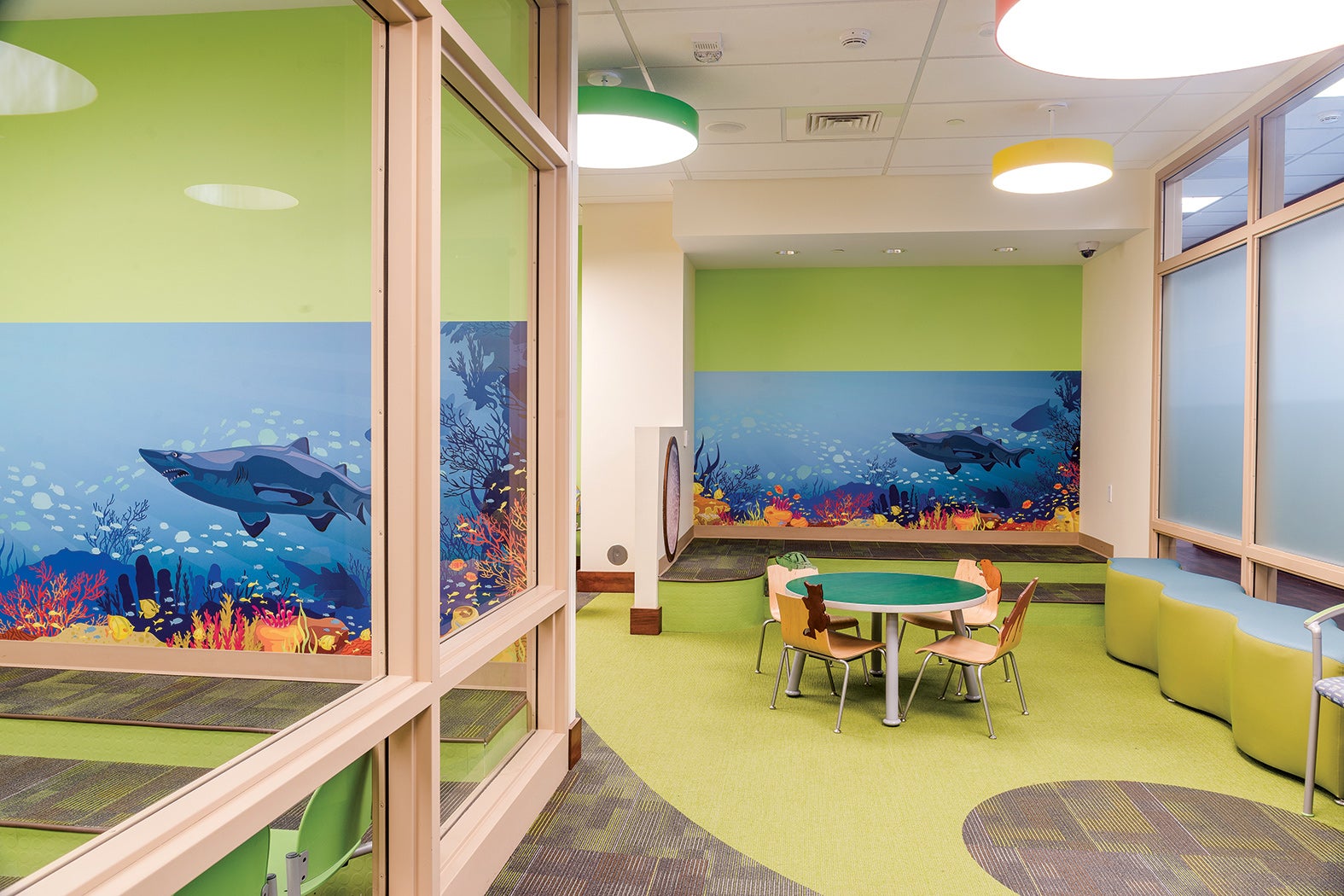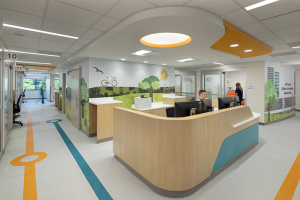Creating sustainable and durable health care interiors
Sustainable interiors are beneficial to the people who use health facilities and to the people who operate them.
“In recent years, environmental sustainability has emerged as an integral part of mainstream business management in health care organizations,” says Bo Barber, vice president of marketing and business development for commercial flooring manufacturer Ecore, Lancaster, Pa. “The importance of health care facilities' specifying sustainable products is now even more important.”
‘A win-win’
“Specifiers are looking for products that sustain the ability of the building environment to support people, while also sustaining the ability of the natural environment to support generations of people to come,” Barber says. Ecore surfaces are manufactured to provide safety, ergonomic and acoustic benefits. “All flooring is not created equal, when it comes to these critical performance characteristics,” he says.
Ecore flooring products are derived from reclaimed waste, primarily recycled truck tires. The company reports that it diverted more than 1 million tires from landfills last year and upcycled the material into high-performance surfacing.
Ecore’s Forest rx surface, comprising a vinyl wear layer bonded to a recycled rubber backing, is made from 65 percent postconsumer recycled content. Using a patented manufacturing process, Ecore pairs recycled rubber underlayments with a variety of materials like vinyl, rubber, carpet and turf.
Amy Costello, sustainability manager for Armstrong Flooring Inc., also based in Lancaster, Pa., says the use of sustainable materials has developed from being trendy to being the way to do business. “Hospitals and health facilities are realizing that it’s really positive not only for their bottom lines, but also for their patients and customers,” she says. “It’s really a win-win for everyone.”
Costello says, “Flooring materials that enhance the patient experience, are easy to maintain and contribute to indoor-air quality are important to health care. Flooring with a higher light reflectivity can even help to reduce energy use at a facility by allowing organizations to use lower-wattage bulbs or fewer lighting fixtures to produce the needed light in a space.”
Durability is another quality of sustainable materials. Armstrong’s new, patent-pending Diamond 10 technology infuses the company’s flooring products with cultured diamonds for increased durability and easier cleaning. “It’s easy to clean the flooring and it lasts a long time, so you’re not inconveniencing or disturbing the patients in a facility,” says Costello. “In health care, sustainability is all about the patients.”
You may also like |
| 2015 Sustainable Operations Survey |
| Improving sustainability through product choices |
| Trends in health care furniture |
|
|
Casey Johnson, North American Marmoleum business development manager for flooring manufacturer Forbo, Hazelton, Pa., says, “We look at health as being the most important factor in sustainability right now. There is more attention being paid to the potential impacts of building products on patient and employee health.”
Given the amount of time people spend indoors, “buildings should be developed with the health and wellness of building occupants at the center of design,” Johnson says. Forbo’s commitment to sustainability involves all aspects of health, well-being and comfort, he adds. “We strive to create safe, nontoxic environments by offering easy-to-clean floors that reduce allergy burden and control bacterial growth without chemical additives.”
Forbo’s Marmoleum flooring is manufactured from 100 percent bio-based materials. The product contains no materials that are red-listed on the International Living Future Institute’s Declare labels, an industry standard for material transparency; facilities with restricted chemical lists can be confident that Marmoleum meets their requirements, Johnson says. Forbo’s Topshield 2 occupancy-ready factory finish requires no initial maintenance or polymer application and no aggressive chemicals to maintain. According to Johnson, the company’s flooring provides excellent acoustics and appropriate light reflectance, as well.
Healthy options
Furniture and architectural wall manufacturer KI, Green Bay, Wis., is working with Practice Greenhealth’s Healthier Hospitals Initiative to make it easier for specifiers to select products that support a facility’s sustainability mission, says Debbie Breunig, R.N., EDAC, vice president of health care, KI. Practice Greenhealth is a nonprofit membership organization focused on environmental stewardship in health care. “They’re really good at breaking down how to have a healthier overall practice,” Breunig says.
This includes the development of what she calls realistic and achievable goals for chemical use; for example, a facility's goal may be that 30 percent of its annual volume of furnishings purchases should eliminate a certain chemical. “As a manufacturer, we can look at that and provide a list of products” that will help to meet that goal, Breunig says. While facilities may not be able to eliminate the use of certain chemicals, reducing the amount they use “is really a healthy goal and a good initiative for them to put in place,” she notes.
Another good environmental practice is using products that have long life cycles. KI furniture is designed with components that are easily replaced in the field, so facilities can manage wear and tear or update the look of individual pieces over time. The company’s architectural wall solutions reduce the amount of construction debris on a job site, and can be reconfigured to meet future needs.
Without long-lasting products, “you’re filling up landfill with either furniture that can’t stand up to the 24/7 environment or you’re filling up landfill with drywall or debris from construction,” Breunig says.
Kristin Moore, director of health care for DIRTT Environmental Solutions, Calgary, Alberta, manufacturer of custom interiors, says the pace of change in health care is driving providers to recognize that their facilities must be adaptable. “They’re having to abandon their investment in construction over and over again to keep up with the changes that are happening,” she says. Material choices are important to sustainability, but the next level involves looking at behaviors that are sustainable from a construction standpoint, Moore explains.
According to Moore, traditional construction produces a pound of material waste per square foot of drywall. DIRTT’s custom-built, pre-engineered walls arrive on-site with electrical, medical gas and plumbing chases installed and architectural finishes applied.
This results in dust-free construction with no material waste. Each wall is created from independent layers that allow facilities teams to easily remove, for example, the face of the wall to access the cavity; users can make changes to a wall without punching into drywall. Plus, the entire wall system can be reconfigured, creating a platform that is adaptable moving forward.
The company’s new Leaf folding wall, which can be retrofit into existing DIRTT environments, expands this adaptability even more.
Moore explains that DIRTT’s manufacturing and construction process enables health care organizations to put resources toward materials that might otherwise get value-engineered out of a project. Materials that are more durable or have a smaller environmental footprint may cost more, but efficient, off-site manufacturing and quick installation reduce construction labor costs, so organizations “don’t lose those materials when construction costs start going over[budget], which is what happens in conventional construction,” she says. “The money goes toward tangible things they own, as opposed to labor that is on-site for the duration of that build and then goes away.
“And then, from a sustainability standpoint, they have an interior solution that becomes something they can use for the next 50 years. It doesn’t have to get torn out because it’s not working for them anymore.”
Amy Eagle is a freelance journalist based in Homewood, Ill., who specializes in health care-related topics. She is a regular contributor to Health Facilities Management.






